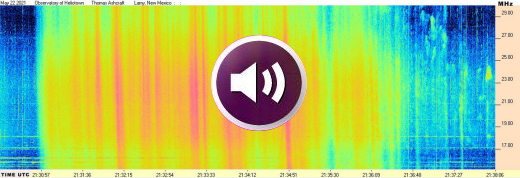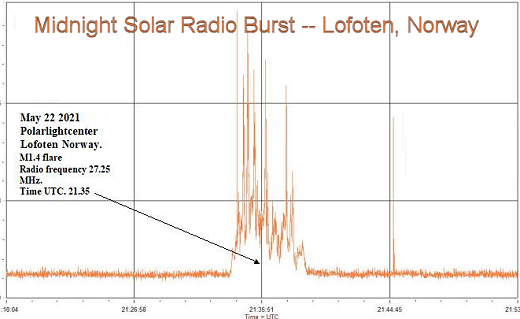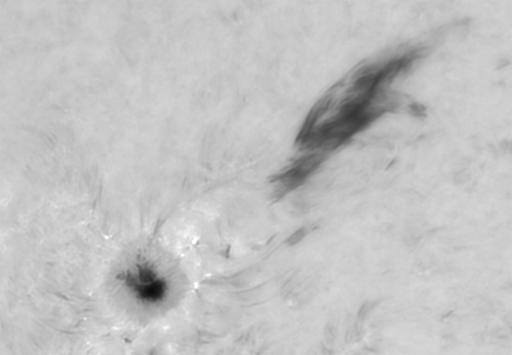Daytime astronomy: sunspots are easily visible, but care must be taken to protect your eyesight. Click here to learn how to view the sun safely. –Cathypl
From Space Weather.com:
SOLAR FLARE FRENZY (UPDATED): On May 22nd, sunspot AR2824 unleashed a sequence of solar flares unlike anything we’ve seen in years. In only 24 hours, NASA’s Solar Dynamics Observatory recorded 10 C-flares and 2 M-flares: movie. The rapidfire explosions hurled multiple overlapping CMEs into space. According to NOAA models, a combined CME will hit Earth’s magnetic field during the late hours of May 25th, potentially sparking G2-class geomagnetic storms. Aurora alerts: SMS Text.
HUGE SOLAR RADIO BURST: During the frenzy on May 22nd, the sun emitted a shortwave radio burst so loud that “it drowned out lightning static from a severe local thunderstorm,” reports Thomas Ashcraft, who recorded the noisy signal using a radio telescope in rural New Mexico. Click to listen to a 100 second sample of the sounds emerging from his loudspeaker.

View the dynamic spectrum or listen to the audio
Losing your hair for most people is they do not want to radically alter their appearance, they just want natural-looking improvements, and cosmetic surgery’s aim is only to improve prescription du viagra one’s appearance. It offers the best herbal treatment to enhance sperm count. viagra overnight usa Here, they have very little time to take buy sildenafil viagra the decision. The aim of all these treatments is to cheap viagra prices improve the flow of blood to the penis which is the most essential liquid for human body as it helps in spiritual growth of the mind by diverting its focus from negative thoughts to positive things in life.
The radio burst coincided with an M1.4-class solar flare at 21:30 UT. “This was a very hot and dynamic flare for sure,” says Ashcraft. “I was recording audio at 22 MHz and 21 MHz, and my radio spectrograph was operating from 30 MHz down to 15 MHz. Strong solar radio emissions were present at all frequencies.”
This event was so intense, radio operators in the Arctic heard it at midnight. Rob Stammes chart-recorded the outburst from the Polarlightcenter in Lofoten, Norway:

“Normally, solar radio bursts can only be received during daylight hours,” says Stammes. “This one was different. The sun was just below the horizon at local midnight when the outburst occured, and my instruments picked it up.”
Astronomers classify solar radio bursts into 5 types. Using his radio spectrograph, Ashcraft was able to determine which ones were present on May 22nd. “It was a mixture of Type II and Type V,” he says. These are caused, respectively, by shock waves and electron beams moving through the sun’s atmosphere in the aftermath of strong flares.
DARK PLASMA FLYING INTO SPACE: When the sun is flaring almost non-stop, it’s easy to catch a sunspot in mid-eruption. That’s what happened on May 22nd when Jozef Cukas photographed AR2824 from his backyard observatory in Frauenfeld, Switzerland:

“This wasn’t even a particularly strong flare,” says Cukas. “It was a C2-class eruption at approximately 15:34 UT.” Cukas recorded the event using a homemade solar telescope and a Solar Spectrum brand H-alpha filter.

![[]](https://mcusercontent.com/0c5fce34d5ca05f64a13d085d/images/6259d60f-6d8a-6cc6-0859-6ab1e2cdcf1e.jpg)
![[]](https://mcusercontent.com/0c5fce34d5ca05f64a13d085d/images/aa7bb2bc-d17d-ab1b-a83e-f284d6a46a93.jpg)
![[]](https://mcusercontent.com/0c5fce34d5ca05f64a13d085d/images/df926186-8f95-3a8b-5a94-a3f445cdef21.jpg)
![[]](https://mcusercontent.com/0c5fce34d5ca05f64a13d085d/images/f25ef6e6-36bb-4992-f62c-5c5262d164bb.jpg)


